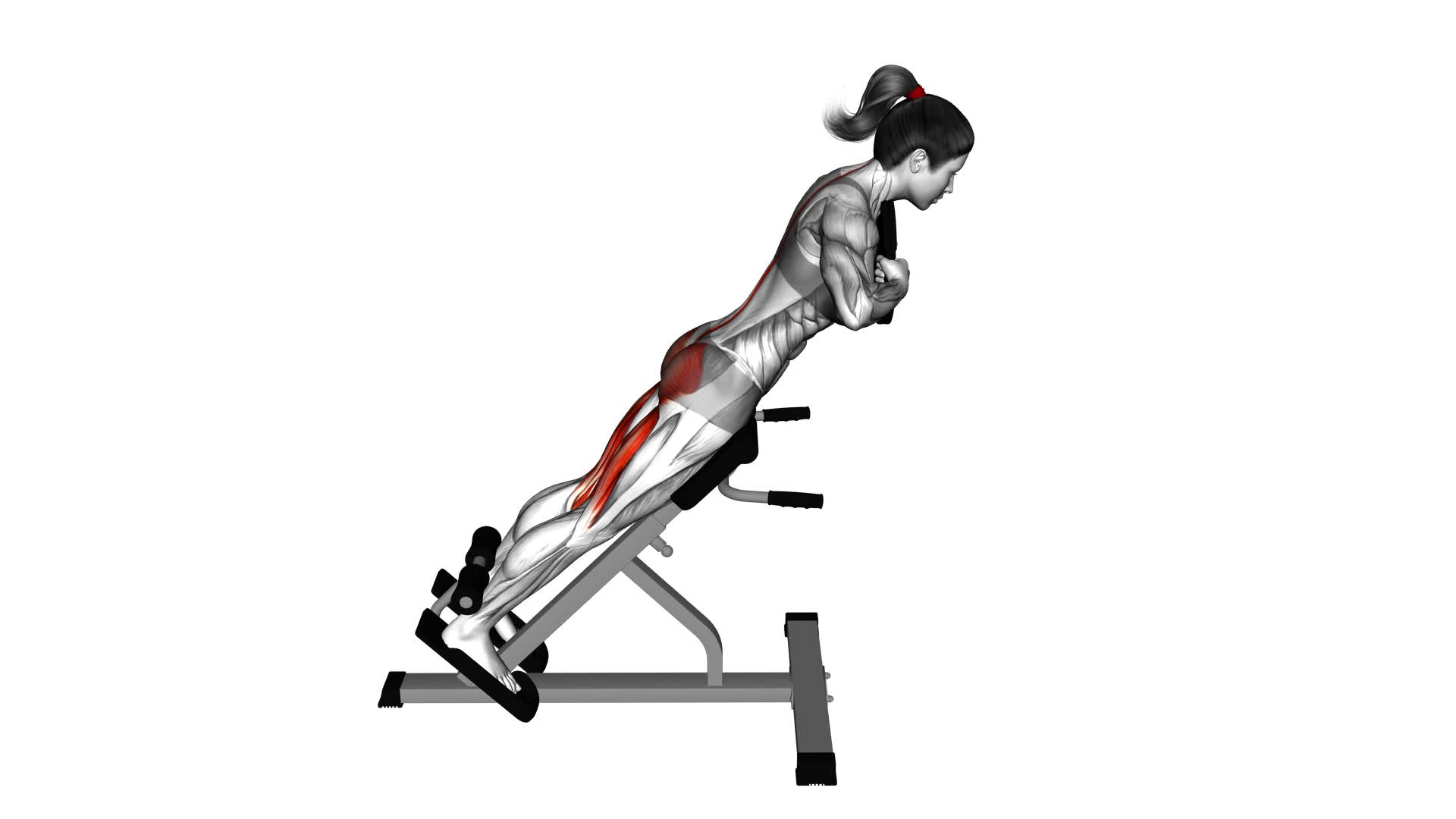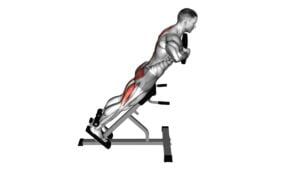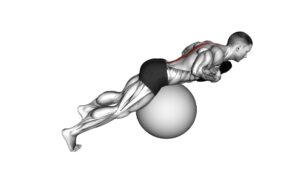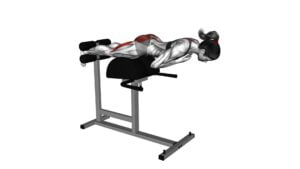Weighted Hyperextension (female) – Video Exercise Guide & Tips

Looking to strengthen your lower back and glutes? Check out this video exercise guide for weighted hyperextension.
Watch This Exercise Video
This intense workout targets the muscles in your posterior chain, helping to improve posture and prevent lower back pain. Learn the proper form and technique, as well as safety precautions and modifications.
With these tips, you can maximize the effectiveness of your weighted hyperextension routine. Get ready to feel the burn and see results!
Key Takeaways
- Weighted hyperextension targets muscles in the posterior chain.
- Weighted hyperextension improves posture and prevents lower back pain.
- Weighted hyperextension strengthens the lower back, glutes, and hamstrings.
- Weighted hyperextension reduces the risk of injury and improves stability.
Benefits of Weighted Hyperextension
To maximize the effectiveness of your workout, it's important to understand the benefits that weighted hyperextension exercises can provide. Weighted hyperextensions are a powerful tool for injury prevention and muscle activation. These exercises specifically target the muscles of the lower back, glutes, and hamstrings, which are crucial for maintaining proper posture and preventing lower back pain. By strengthening these muscles, you can reduce the risk of injury and improve overall stability.
One of the key benefits of weighted hyperextensions is their ability to strengthen the erector spinae muscles, which run along the spine and are responsible for keeping the back upright. By strengthening these muscles, you can improve your posture and reduce the strain on your spine during daily activities and workouts.
In addition to injury prevention, weighted hyperextensions also activate the glutes and hamstrings. These exercises engage the gluteus maximus, the largest muscle in the buttocks, as well as the hamstrings, which are crucial for hip extension and knee flexion. By activating and strengthening these muscles, you can improve your athletic performance and enhance your overall lower body strength.
Proper Form and Technique
To perform the weighted hyperextension exercise with proper form and technique, there are a few common mistakes to avoid. These include:
- Using too much weight
- Rounding your back
- Not engaging your core
By maintaining proper technique, you can maximize the benefits of this exercise, such as:
- Strengthening your lower back, glutes, and hamstrings
- Improving your posture
- Reducing the risk of injury.
Common Mistakes to Avoid
Avoid these common mistakes when performing the weighted hyperextension exercise to ensure proper form and technique.
- Overexertion: One of the most common mistakes is trying to lift too much weight or overextending the back. This can put excessive strain on the lower back and increase the risk of injury. Focus on using a weight that challenges you without compromising your form.
- Incorrect positioning: Another mistake isn't properly aligning your body during the exercise. Make sure your hips are placed securely on the hyperextension bench and your feet are firmly planted on the ground. Keep your back straight and engage your core muscles throughout the movement.
- Lack of control: Many people rush through the exercise, sacrificing control for speed. Take your time and perform each rep with proper control and range of motion. This will help you target the correct muscles and maximize the benefits of the exercise.
Benefits of Proper Technique
Maximizing the benefits of the weighted hyperextension exercise is crucial when you perform it with proper form and technique. By executing the exercise correctly, you can ensure that you're targeting the intended muscles effectively and avoiding unnecessary strain on your body.
Proper technique allows you to engage your glutes, hamstrings, and lower back muscles more efficiently, maximizing the results of your workout. Additionally, using proper form helps to reduce the risk of injuries that may occur when performing the exercise incorrectly. It's important to maintain a neutral spine, engage your core, and perform the movement in a controlled manner.
By focusing on proper technique, you can achieve optimal results while minimizing the risk of injuries.
Now, let's move on to discuss the equipment needed for the weighted hyperextension exercise.
Equipment Needed for Weighted Hyperextension
You will need some basic equipment to perform weighted hyperextensions effectively. Here are the three items you'll need:
- Hyperextension Bench: A hyperextension bench is specifically designed for performing hyperextensions. It typically has a padded platform and adjustable height to accommodate users of different sizes. The bench provides stability and support for your body during the exercise.
- Weight Plate: To add resistance to your hyperextensions, you'll need a weight plate. Start with a weight that challenges you but allows you to maintain proper form. Gradually increase the weight as you get stronger and more comfortable with the exercise.
- Weight Belt: A weight belt is optional but can provide additional support and stability during weighted hyperextensions. It helps to protect your lower back by providing compression and stability to the lumbar region. If you're lifting heavy weights or have a history of lower back issues, using a weight belt may be beneficial.
These three pieces of equipment are essential for performing weighted hyperextensions effectively and safely. Make sure to choose the appropriate weight and use proper form to maximize the benefits of this exercise.
Safety Precautions and Modifications
To ensure safety and maximize the benefits of the weighted hyperextension exercise, it's crucial to maintain proper form throughout the movement. This involves keeping your core engaged, your back straight, and avoiding any jerky or sudden movements.
Additionally, it's important to listen to your body and avoid overexertion, as pushing beyond your limits can increase the risk of injury.
For beginners, modifications such as starting with lighter weights or using bodyweight only can help build strength and gradually progress towards more challenging variations of the exercise.
Proper Form Importance
Maintaining proper form during weighted hyperextensions is crucial for ensuring your safety and maximizing the effectiveness of the exercise. Here are three reasons why proper form is important:
- Importance of core strength: The weighted hyperextension primarily targets your lower back muscles, but it also engages your core muscles. By maintaining proper form, you can effectively strengthen and stabilize your core, which is essential for overall strength and stability in daily activities and other exercises.
- Preventing lower back injuries: Improper form during weighted hyperextensions can put excessive strain on your lower back, increasing the risk of injuries such as muscle strains or herniated discs. By maintaining proper alignment and control throughout the movement, you can minimize the stress on your lower back and reduce the likelihood of these injuries.
- Maximizing exercise effectiveness: Proper form ensures that you're targeting the intended muscles and engaging them to their fullest potential. By performing the exercise with correct technique, you can optimize the effectiveness of the workout, leading to better results in terms of strength, endurance, and muscle development.
By understanding the importance of proper form, you can perform weighted hyperextensions safely and efficiently, minimizing the risk of injuries and maximizing the benefits of the exercise.
Now, let's move on to the next section, where we'll discuss how to avoid overexertion risks.
Avoiding Overexertion Risks
To avoid overexertion risks and ensure your safety during weighted hyperextensions, it's important to implement safety precautions and modifications.
By following these guidelines, you can minimize the risk of injury and prevent muscle strain.
Firstly, it's crucial to start with an appropriate warm-up routine to prepare your muscles for the exercise. This can include dynamic stretches and light cardio exercises. Additionally, make sure to choose a weight that's suitable for your fitness level and gradually increase it over time. Avoid using weights that are too heavy, as this can put excessive strain on your back and increase the chances of injury.
Furthermore, maintaining proper form throughout the exercise is essential. Keep your core engaged, shoulders back, and spine neutral. Avoid arching your back or jerking the weight, as this can lead to muscle strain. Instead, focus on controlled and smooth movements.
Lastly, listen to your body and take breaks if you start to feel discomfort or pain. Pushing through pain can exacerbate injuries, so it's crucial to prioritize your safety.
Modifications for Beginners
Ensure your safety during weighted hyperextensions by implementing modifications and safety precautions, especially if you're a beginner. Here are some beginner modifications and progressions for beginners to help you get started:
- Start with bodyweight: If you're new to weighted hyperextensions, it's important to first master the exercise without any additional weight. Focus on proper form and technique before progressing to weighted variations.
- Use lighter weights: When adding weights, start with lighter ones to avoid straining your lower back. Gradually increase the weight as you build strength and confidence.
- Perform partial range of motion: If you find it challenging to perform a full range of motion, start by doing partial reps. This allows you to work within your current capabilities and gradually increase your range as you get stronger.
By implementing these modifications and progressions for beginners, you can safely and effectively perform weighted hyperextensions.
Now, let's move on to the next section for tips on maximizing the effectiveness of this exercise.
Tips for Maximizing the Effectiveness of Weighted Hyperextension
How can you make weighted hyperextensions more effective?
One way to maximize the results of weighted hyperextensions is by increasing the resistance. As you become more comfortable with the exercise, gradually increase the weight used to challenge your muscles even further. This will help to build strength and improve the effectiveness of the exercise.
Another tip for maximizing the effectiveness of weighted hyperextensions is to focus on maintaining proper form throughout the movement. Keep your back straight, engage your core muscles, and avoid rounding your spine. This will ensure that you're targeting the correct muscles and reduce the risk of injury.
Additionally, it can be beneficial to vary the tempo of the exercise. Slow down the movement on the way down and pause briefly at the bottom before explosively contracting your glutes and hamstrings to lift your body back up. This will increase the time under tension and make the exercise more challenging.
Lastly, don't forget to breathe properly during the exercise. Inhale as you lower your body and exhale as you lift it back up. This will help to stabilize your core and provide the necessary oxygen to your muscles.
Sample Workout Routine Incorporating Weighted Hyperextension
To incorporate weighted hyperextensions into your workout routine, start by performing the exercise with proper form and gradually increase the resistance as you become more comfortable. This sample workout routine will help you maximize the effectiveness of weighted hyperextensions:
- Warm-up: Begin with 5-10 minutes of light cardio to get your blood flowing and prepare your muscles for the workout.
- Weighted Hyperextensions: Start with a weight that challenges you but allows you to maintain proper form. Aim for 3 sets of 10-12 repetitions. As you progress, gradually increase the weight to continue challenging your muscles.
- Superset with Core Exercises: To further engage your core, superset your weighted hyperextensions with exercises like planks or Russian twists. Perform 2-3 sets of 10-12 repetitions for each exercise.
- Rest and Recovery: Allow yourself 1-2 minutes of rest between sets to recover and catch your breath. Remember, proper form is more important than the amount of weight lifted, so listen to your body and adjust as needed.
Frequently Asked Questions
How Many Sets and Reps Should I Do for Weighted Hyperextensions?
To maximize the benefits of weighted hyperextensions for core strength and stability, it's important to determine the appropriate sets and reps for your fitness level. Start by incorporating variations of weighted hyperextensions into your workouts to make them more challenging.
As you progress, you can increase the number of sets and reps gradually. Remember to always listen to your body and consult a fitness professional for personalized guidance.
Can I Use a Resistance Band Instead of Weights for This Exercise?
Yes, you can definitely use a resistance band instead of weights for the weighted hyperextension exercise. Resistance bands provide a different type of resistance that can be effective for targeting the muscles involved in this exercise.
However, it's important to note that using weights can offer additional benefits such as increased load and muscle activation.
Ultimately, the choice between resistance bands and weights depends on your fitness goals and personal preferences.
Is Weighted Hyperextension Suitable for Beginners or Should It Only Be Done by More Advanced Individuals?
Weighted hyperextension is a great exercise for building overall strength and stability. It can be suitable for beginners if done with proper technique and progression. Starting with bodyweight hyperextensions is a good way to build the necessary strength before adding weights.
As you become more advanced, you can gradually increase the weight to continue challenging your muscles. Just remember to always listen to your body and consult with a professional if you have any concerns.
Can Weighted Hyperextensions Help to Improve Posture?
Weighted hyperextensions can be an effective exercise for improving posture. By targeting the muscles in your lower back and glutes, this exercise helps to strengthen and stabilize your spine, promoting better alignment.
To reap the benefits, it's important to maintain proper form and technique. Make sure to keep your back straight, engage your core, and avoid arching or rounding your spine.
Consistency and gradual progression with weighted hyperextensions can lead to noticeable improvements in your posture.
Are There Any Alternative Exercises That Target the Same Muscle Groups as Weighted Hyperextensions?
Looking for alternative exercises to target the same muscle groups as weighted hyperextensions? There are a few options you can try.
- One effective exercise is the glute bridge, which activates your glutes and lower back muscles.
- Another option is the superman exercise, where you lie on your stomach and lift your arms and legs off the ground.
Both of these exercises can help strengthen your posterior chain and improve overall posture.
Incorporating weighted hyperextensions into your workout routine can provide additional benefits.
Conclusion
In conclusion, incorporating weighted hyperextension into your workout routine can provide numerous benefits. This exercise is particularly effective for strengthening your lower back, glutes, and hamstrings. It targets these muscle groups specifically, helping to build strength and stability in those areas.
To get the most out of weighted hyperextensions, it's important to use proper form and technique. This means keeping your back straight and engaging your core throughout the movement. Additionally, it's crucial to take necessary safety precautions. This includes using appropriate equipment, such as a hyperextension bench, and ensuring that the weight you are using is manageable for your fitness level.
Starting with lighter weights and gradually increasing the load is also essential. This allows your body to adapt and prevents any potential injuries.
By adding weighted hyperextensions to your fitness regimen, you can enhance your overall strength and stability. This exercise is a great addition to any workout routine, especially for those looking to target their lower back, glutes, and hamstrings. So, give it a try and enjoy the benefits it brings to your fitness journey.

Author
Years ago, the spark of my life’s passion ignited in my mind the moment I stepped into the local gym for the first time. The inaugural bead of perspiration, the initial endeavor, the very first surge of endorphins, and a sense of pride that washed over me post-workout marked the beginning of my deep-seated interest in strength sports, fitness, and sports nutrition. This very curiosity blossomed rapidly into a profound fascination, propelling me to earn a Master’s degree in Physical Education from the Academy of Physical Education in Krakow, followed by a Sports Manager diploma from the Jagiellonian University. My journey of growth led me to gain more specialized qualifications, such as being a certified personal trainer with a focus on sports dietetics, a lifeguard, and an instructor for wellness and corrective gymnastics. Theoretical knowledge paired seamlessly with practical experience, reinforcing my belief that the transformation of individuals under my guidance was also a reflection of my personal growth. This belief holds true even today. Each day, I strive to push the boundaries and explore new realms. These realms gently elevate me to greater heights. The unique combination of passion for my field and the continuous quest for growth fuels my drive to break new ground.



